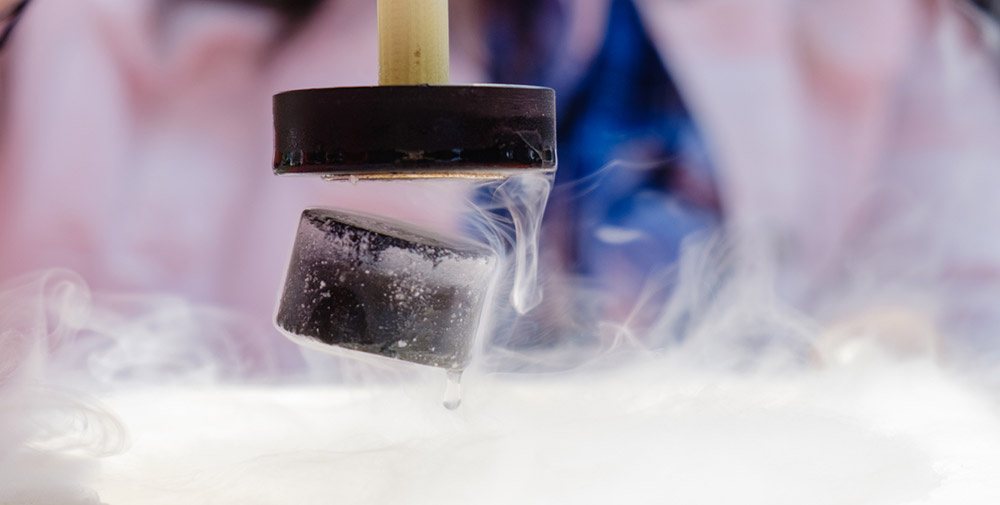wrong data? In 2020, researchers succeeded for the first time in making a superconducting material at room temperature — at least that’s what they report. But doubts about this achievement are now growing and “Nature” has withdrawn its specialized article. The reason for this is the undocumented processing of magnetic field data, but also problems with experiment reproduction. Since then, authors and critics have been arguing about whether superconductivity has been demonstrated at room temperature.
Common high-temperature superconductors need low temperatures to become resistance-free conductors. Because only then their electrons assume states that allow them to move without resistance in the material. However, in recent years physicists have discovered a class of materials that become superconducting under high pressure even at moderate temperatures – Metal hydrate. This is how he loses Lanthanum hydride Already at 23 degrees below the resistance and Hydrogen sulfide At least 70 degrees below zero.
In October 2020, “Nature” magazine published this on its front page big bang: A team led by Ranga Dias of the University of Rochester in New York has succeeded in making superconducting hydride with a temperature of more than 15 degrees — at nearly room temperature. Although this also requires a very high pressure of 275 GPa, it appears that an important breakthrough has been achieved – the first room-temperature superconductivity.
suspicious magnetic data
But in the meantime, doubts are growing about this achievement – and about the sincerity of the team of physicists. The controversy arose not because of the apparent decrease in electrical resistance in the experiment, but from data on the magnetic behavior of sulfur hydride, carbon and hydrogen. In addition to lossless electrical conductivity, an essential characteristic of true superconductivity is also the effect of a shield against external magnetic fields.
Although Dias and his team provided data about this magnetic behavior in their paper, they have been largely edited. Accordingly, the decisive signal appeared only after the “background signal” was subtracted. However, these background data or preliminary data have not been published. Nature pulled the paper in September 2022 due to growing criticism of the measure. Rationale: The researchers used a custom, non-standard method and did not disclose details in the article.
The raw data does not match the paper
In response to the criticism, Dias and one of his colleagues later provided raw data from their experience as a primary publication. However, after closer analysis, physicists Jorge Hirsch of the University of California at San Diego and Dirk van der Marel of the University of Geneva also questioned this data. Your accusation: The raw data published later does not match the paper published in the journal Nature. According to the researchers, they could not have come from the same experience.
Dias and his team defended themselves against these allegations and in turn accused Hirsch of personal revenge. In fact, Hirsch has been temporarily banned from the arXiv prepress platform due to his constant attacks on Slides and its partners. He is also known as a strong critic of hydride superconductors. “We stand by our work, and it has been experimentally and theoretically validated,” Dias told Science.
Reproduction has not yet succeeded
However, Hirsch is not the only physicist to express skepticism about the procedure used by Dias and his team and the preliminary data that were later published. “This raises more questions than it answers,” Cornell University’s Brad Ramshaw explained in a recent Science publication. To make matters worse, the experiment has so far not been able to reproduce other teams. It appears that Mikhail Eremets of the Max Planck Institute for Chemistry in Mainz, who has researched hydrogen sulfide as a high-pressure superconductor, has not worked either — also because some basic information about the procedure was missing.
Whether a room-temperature superconductor actually exists remains an open question at present. However, there appears to be a general consensus among solid-state physicists that hydrides as well as hydrides with mixtures of carbon can be a promising approach for new high-temperature superconductors. (nature retreatMatter and radiation at the extremes, 2022; doi: 10.1063/5.0088429)
Source: Science, Nature

“Total coffee aficionado. Travel buff. Music ninja. Bacon nerd. Beeraholic.”







More Stories
Researchers detect extremely high-energy gamma rays
Anxiety disorders in old age increase the risk of dementia
Researchers are particularly fascinated by these exoplanets.